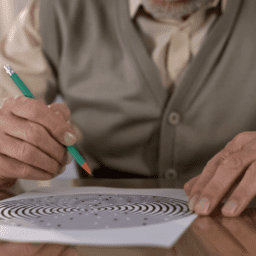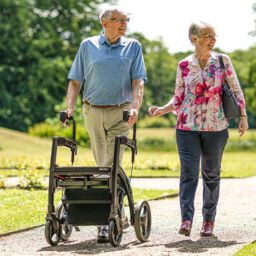Do you sometimes feel like your feet are stuck to the floor, or your hips are glued to your chair, despite your best efforts and desire to move them? This is called freezing or freezing of gait (FOG), and approximately 30-67% of people diagnosed with Parkinson’s experience it, with a higher incidence rate experienced in later stages
We recently spoke to Jay L. Alberts, PhD, the Vice Chair of Innovations of the Neurological Institute at the Cleveland Clinic, about FOG, postural instability, and how exercise can help.
Issues with balance and movement are common symptoms of Parkinson’s. Our primer on balance and Parkinson’s can be found here. Postural instability, characterized by unsteadiness while standing and balance issues, is one of the four core motor symptoms of Parkinson’s, along with tremor, bradykinesia, and rigidity. Postural instability is also linked to FOG, the feeling of being stuck in place.
When you freeze, your brain tells your body to move, but it doesn’t comply. These symptoms often cause falls because your upper body may keep moving while your feet are frozen/stuck to the floor. Many people report that FOG is most likely to happen when they’re going from standing still to walking, starting to climb downstairs, changing direction, wanting to act in a hurry, or trying to get around an obstacle. Because these are actions we take regularly, it’s not hard to see how FOG can affect one’s quality of life.
We usually think about multitasking as trying to read a newspaper and listen to the radio simultaneously or talking on the phone while making dinner. Dr. Alberts describes dual tasking more specifically as “processing cognitive information and monitoring motor function simultaneously.”
An example of dual tasking is shopping in a department store: you might be checking sizes and price tags on shirts while your brain is simultaneously trying to process the people around you and any obstacles that may be in your way. These are things most people do without thinking. People with Parkinson’s, however, often have diminished attentional resources. So, if you are attending to a cognitive task (thinking about a pair of shoes you are interested in), your motor functionality may decrease.
Dual tasking and the neurological pathways that lead to postural instability and FOG are extremely complicated, making them difficult to treat. The frontal lobes, cerebellum, and basal ganglia are all involved in cognition and movement, and when the connections between them and to other parts of the brain are disrupted or altered (like by the loss of dopamine), it can be very challenging for the brain to perform motor and cognitive tasks. Effective multitasking requires seamless connections between neurons and the ability of neurons to respond to more than one stimulus at a time. However, when dopaminergic nerve cells die as they do in Parkinson’s, those connections and conversations between various parts of the brain don’t work as well.
Researchers are considering many hypotheses for why FOG and postural instability occur. One theory is that when your brain prioritizes a cognitive task, the cross-communication between brain structures gets overloaded, and mobility fails. Beyond the neurons, movement and balance also require effective communication between the brain and the rest of the body. When those neuronal connections don’t work correctly, the brain cannot direct the body’s movement.
“As dopamine neurons are mostly depleted in PD patients, concurrent processing of cognitive and/or limbic information during motor tasks will overload the information processing capacity within basal ganglia, thus leading to disordered neuronal crosstalk between these circuits. The interference between neural circuits would explain the phenomena that increasing cognitive load while performing a dual task will break down the locomotion.” -Gao, et al. (2020)
Freezing of gait and instability are also often made worse by anxiety. For example, standing at the top of a flight of stairs can be stressful, especially if you’re already worried about falling or feel pressured by people behind you to hurry. That worry then consumes your cognitive load and leads to decreased mobility. Allowing yourself time to perform movement tasks at your speed and not focusing on how quickly others around you are going is essential for not overloading your neuronal circuits.
Despite how debilitating FOG, postural instability, and falls can be, there are steps you can take to help address these symptoms.
- Talk to a physical or occupational therapist. Working with a professional can help you with stretches, strength exercises, and mobility devices that can help address these symptoms.
- Try a walker, cane, or guiding lasers, which a physical or occupational therapist can recommend.
- Walk with a partner while each of you is holding one end of a hiking pole or golf club. This can facilitate arm swing rhythm and help you maintain postural stability.
Walking and other exercises can be especially beneficial for combatting motor symptoms. Dr. Alberts recommends cycling, which can improve gait and walking speed, as well as other exercises that strengthen the core—without a strong core, getting in and out of bed or the car or supporting yourself while walking can be challenging, which can exacerbate the risk of postural instability, FOG, and falls
Getting at least three days per week of high or moderate-intensity exercise and doing strength or flexibility training on your days off is essential. As Dr. Alberts put it, high-intensity exercise means that “you should be able to answer who gave the Gettysburg Address but not recite the whole thing.” Essentially, you should be able to say a few words to answer a question, but you shouldn’t be able to have a long conversation. However, he stressed the importance of starting slowly and building your endurance. If you do too much too fast, you may hurt yourself and then be unable to exercise, worsening your postural stability and FOG. In this case, consistency is better than intensity.
You can also alter your environment and behavior to serve you better.
- Install good lighting in your home, including lighted pathways, to help you stay on track and reduce anxiety about falls.
- Try listening to a metronome or a playlist of songs with a consistent number of beats per minute while walking to help with stability.
- Take extra care in familiar surroundings. Dr. Alberts explained that, contrary to what you might expect, most falls occur in familiar circumstances like your home or workplace. Because you are used to your surroundings, your brain tricks you into a false sense of security, and your cognitive processing supersedes your motor functioning. So, stay alert even in places where you feel safe and accustomed.
- Avoid unnecessary dangers like unfamiliar roads on your bike or a different grocery store than you are used to.
- Consider working with a taekwondo or karate expert to teach you how to fall correctly to reduce your potential for injury when falling.
Some medical interventions can be helpful also. For example, many people with Parkinson’s find that increasing their dosage of dopaminergic medications, particularly carbidopa/levodopa, helps reduce FOG and postural instability. Not everyone does, though, so as always, be sure to speak to your doctor or movement disorder specialist (MDS) before making any changes to your medication.
One technique that Dr. Alberts discussed is multimodal therapy, which may be especially helpful. This involves implementing different therapeutic approaches at once. For example, spelling words backward while walking has been found to substantially reduce FOG and the number of falls. You can ask your physical or occupational therapist to help you with this practice to prime you for more unfamiliar environments.
Numerous trials are going on now, including some using augmented reality goggles, to learn more about how postural instability and FOG affect people with Parkinson’s. In the meantime, building an exercise regimen, working with a physical/occupational therapist, speaking to your doctor, or implementing some lifestyle changes can help you address these symptoms and reduce your risk of falls.
Dual-task Augmented Reality Treatment for Parkinson’s Disease (DART)
The Effects of Augmented and Virtual Reality Gait Training on Patients with Parkinson’s Disease
Are you interested in learning more about motor symptoms and how exercise can help? Watch Dr. Alberts’ full presentation or read more about FOG and postural instability. You can also check out some of Dr. Alberts’ previous research on cycling and Parkinson’s or listen to our podcast about how to exercise with Parkinson’s.
Also, did you know that you can improve your balance by taking care of your feet? Dr. Atul Gawande’s book, Being Mortal, dives deep into why feet are a critical part of living well.

















